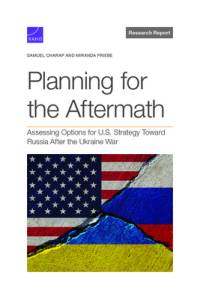Om Planning for the Aftermath
U.S. policy choices made at the conclusions of past wars have had enduring consequences. Although there is no end in sight to the Russia-Ukraine war at the time of this writing in late 2023, U.S. policymakers should begin considering postwar Russia strategy now. The authors of this report address this issue through an alternative futures analysis. Planning for after the war is complicated by significant uncertainty: Neither the conflict's trajectory nor the international climate at the war's end can be predicted with confidence. Given this uncertainty, the implications of U.S. strategic choices must be explored in different contexts. The authors develop two ideal-type postwar worlds, as defined by the outcome of the war and the character of the broader international environment: a less favorable world and a more favorable world. They also propose two ideal-type options for postwar U.S. strategy toward Russia, a hardline approach and a less hardline approach. Then, they consider how each strategy would play out in each world over the course of the decade after the war ends, yielding four alternative futures. They draw on the history of U.S.-Russia relations and the literatures on rivalries, interstate conflict, and alliances to assess the implications of each future for U.S. interests.
Visa mer

